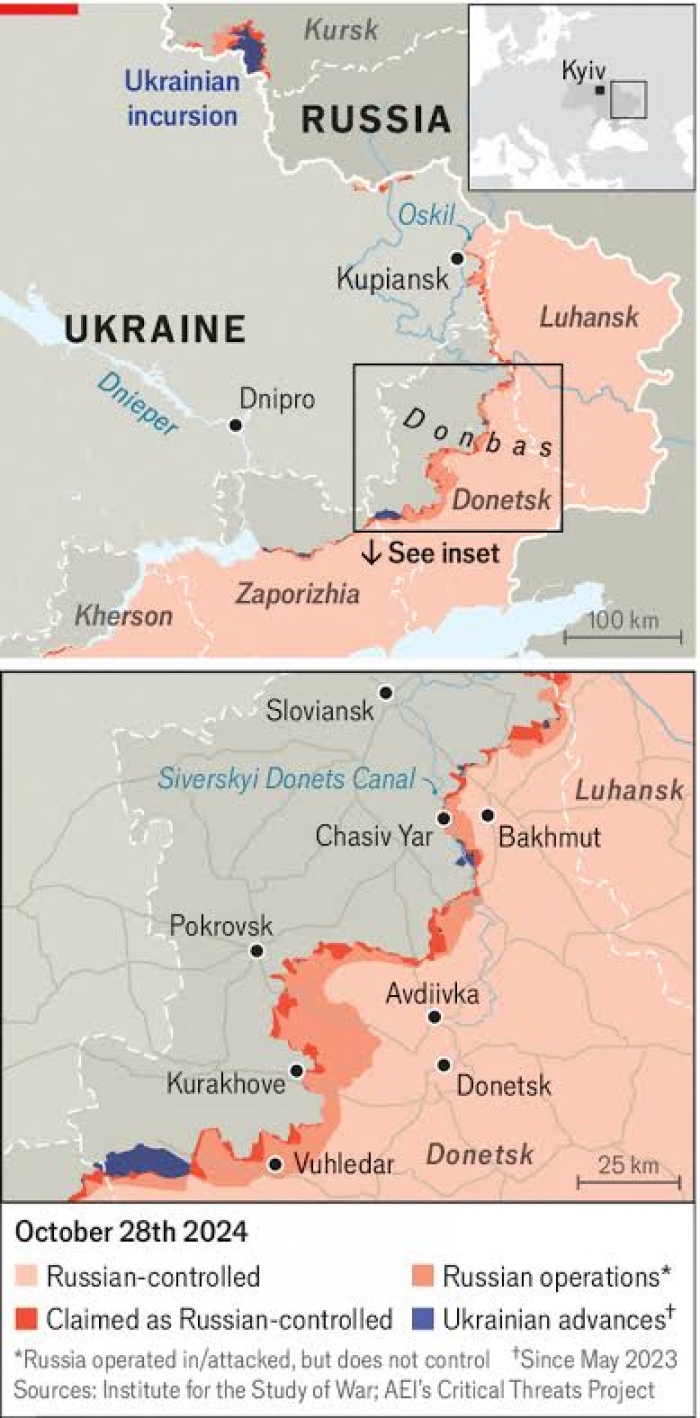“After 970 days of war,” said Lloyd Austin, America’s defence secretary, visiting Kyiv on October 21st, “Putin has not achieved one single strategic objective.” And Mr Austin offered confidence: “Moscow will never prevail in Ukraine.” In private, however, his colleagues in the Pentagon, Western officials and many Ukrainian commanders are increasingly worried about the direction of the war and Ukraine’s ability to hold back Russian advances over the next six months.
Ukrainian forces have managed to hold on to Pokrovsk, an embattled town in the eastern Donbas region—an embarrassment for Mr Putin. But elsewhere along the front, Russia is slicing its way through Ukrainian defences. In Kupiansk in the north, its troops have cut Ukrainian formations in two at the Oskil river. In Chasiv Yar in the east, they have crossed the main Siverskyi Donets canal, after six months of trying. Farther south, Russian troops have taken high ground in and around Vuhledar, and they are moving in on Kurakhove from two directions. In Kursk, inside Russia, Ukraine has lost around half the territory it seized earlier this year.
The problem is not so much the loss of territory, which is limited and has come at enormous cost to Russia—600,000 dead and wounded since the start of the war, on American estimates, and 57,000 dead this year to October alone, according to Ukrainian intelligence. It is the steady erosion in the size and quality of Ukraine’s forces. Ukrainian units are under-strength and overstretched, worn thin by heavy casualties. Despite a new mobilisation law that took effect in May, the army, outside a handful of brigades, has struggled to recruit enough replacements, with young men reluctant to sign up to tours of duty that are at best indefinite and, at worst, one-way missions. Western partners are privately urging Ukraine’s leaders to lower the mobilisation age floor from 25 to increase the potential pool of recruits. But political sensitivities and fears over an already alarming demographic crisis stand in the way of any change.
In a recent essay, Jack Watling of the Royal United Services Institute, a think-tank in London, identifies several reasons for Ukraine’s declining fortunes. One is a shortfall in its air-defence interceptors, allowing Russian reconnaissance drones to establish what he calls “continuous and dense surveillance”. These in turn cue up ballistic-missile and drone strikes against Ukrainian artillery in the rear and glide bombs against troops at the front, allowing Russia to make slow but steady advances in small units, often using motorcycles because tanks are too easy to spot. Ukraine’s limited stock of shells—Russia currently has a two-to-one advantage in shellfire, according to Ivan Havrilyuk, Ukraine’s deputy defence minister—as well as tanks and armoured vehicles compounds that problem. The less firepower and armour are available, the greater the reliance on infantry and the greater the casualties.
Russia is not without its own serious problems. Next year it will spend a third of its national budget on defence, starving the civilian economy in the process. Inflation is perhaps double the official annual rate of more than 8%. In 2025 ordinary Russian families will begin to feel the economic pain for the first time, says a European intelligence official, adding that there are early signs of war fatigue among those closely connected to the conflict, such as mothers and other family members.
On the battlefield, Russia still relies on crude tactics that result in massive casualties. The decision to borrow thousands of North Korean troops, who are thought to be bound for the Kursk front, shows that Russian units are also stretched. Russia’s general staff and defence ministry have put “heavy pressure” on the Kremlin to mobilise more men, says the European official. “Russia now doesn’t have sufficient forces to mass,” says a senior NATO official. “If they achieved a breakthrough they could not exploit it.” There is little short-term risk of Russian troops streaming west to Dnipro or Odessa.
But the crisis in Russia’s war economy is likely to play out over a longer period. Russia’s defence industry depends in part on the refurbishment of Soviet-era stocks, which are getting low in critical areas such as armoured vehicles. It is nonetheless far outperforming Western production lines. The EU claims to be making more than 1m shells per year; Russia is making three times as many, and is also boosted by supplies from North Korea and Iran. “I just don’t know we can produce enough, give enough,” says a person familiar with the flow of American aid, though a recent $800m commitment to boost Ukraine’s indigenous drone production is welcome. “We have no more to give them without taking serious risks in other places.” On manpower, too, Russia remains solvent. Its army is recruiting around 30,000 men per month, says the NATO official. That is less than government targets, but is still enough to cover even the gargantuan losses of recent months.
Russia cannot fight for ever. But the worry among American, European and Ukrainian officials is that Ukraine’s breaking point will come first. “Moscow seems to be wagering that it can achieve its objectives in the Donbas next year,” writes Mr Watling, “and impose a rate of casualties and material degradation on the Ukrainian military high enough that it will no longer be capable of preventing further advances.” That, he warns, would give Russia leverage in any negotiations that follow.
The gloomy mood is evident in a shift in America’s language. Senior officials like Mr Austin still strike a confident note, promising that Ukraine will win. Those involved in the guts of planning in the Pentagon say that, in practice, the ambitions of early 2023—a Ukrainian force that could take back its territory or shock Russia into talks through a well-crafted armoured punch—have given way to a narrow focus on preventing defeat. “At this point we are thinking more and more about how Ukraine can survive,” says a person involved in that planning.


































































